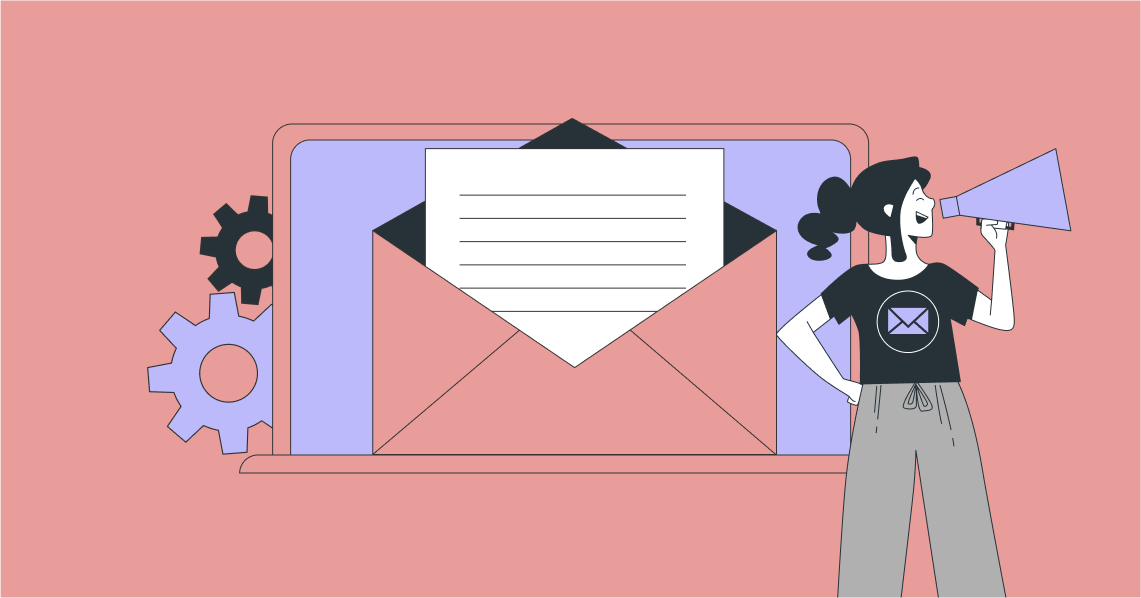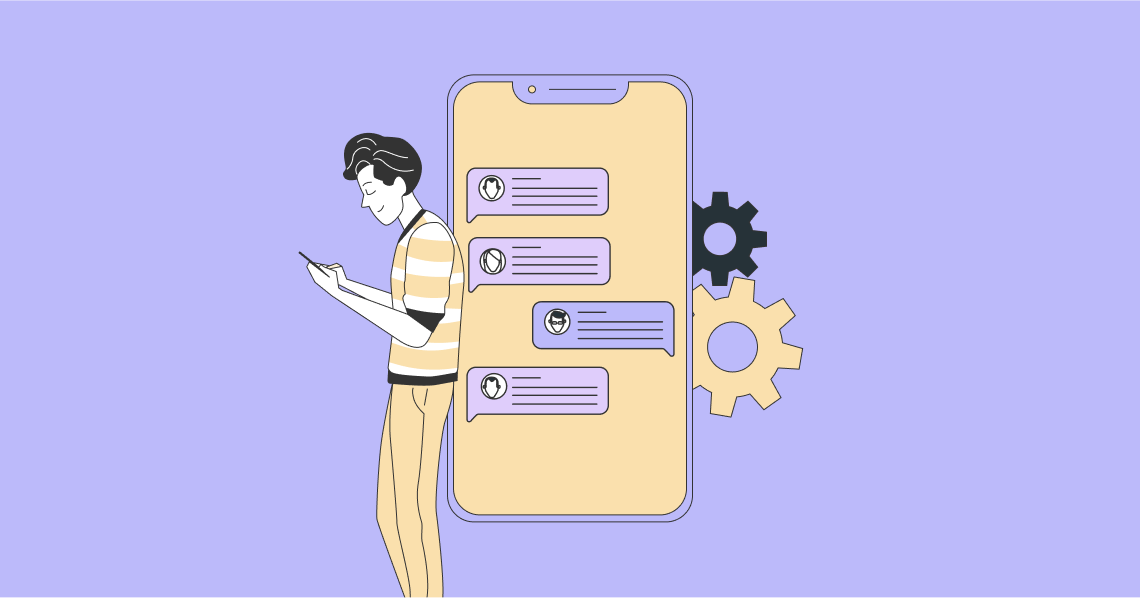In the ever-changing landscape of marketing, there is one constant – the effectiveness of email marketing. Even with the introduction of various strategies for digital marketing, email marketing still remains relevant. It just proves that the best ideas are often the simplest.
So, how do your email marketing campaigns stack up against other marketers? Where should you improve? The following benchmarks and email statistics can help you to gage the effectiveness of your email marketing strategy. Then, if you find that you are missing the (bench)mark, go over our list of best email practices and see which ones you are currently failing to implement.
Benchmarks and Best Practices: What You Need to Know About Email Marketing in 2022:
- 1. Create lead magnets
- 2. Send emails to confirm email addresses
- 3. Plan ahead for events
- 4. Segment, target and personalize
- 5. Include a relevant preheader
- 6. Place important information above the fold
- 7. Include clear CTAs
- 8. Optimize the footer
- 9. Proofread your emails
- 10. Optimize your emails for mobile
- 11. Send emails from a human account
- 12. Make it simple to unsubscribe
- 13. Update your email list
- 14. Conduct A/B testing
- 15. Embrace email automation
- 16. Analyze and adjust
- Frequently Asked Questions
Important Email Benchmarks for 2022
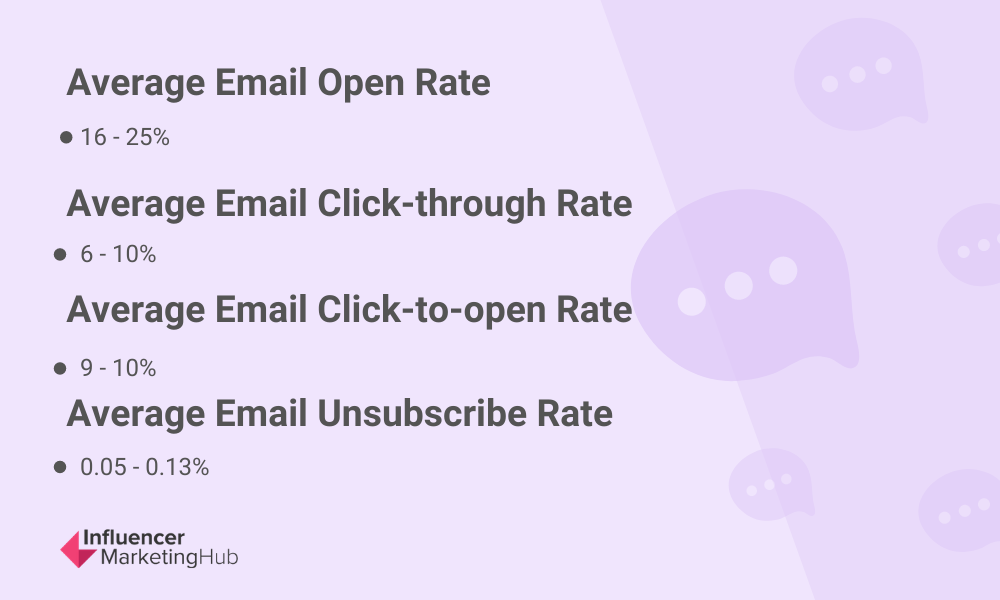
Open rate
The open rate refers to the percentage of the total number of subscribers who opened an email. To work out your open rate, divide the number of opened emails by the number of emails that you sent and multiply the answer by 100.
According to Sendinblue, the average open rate is 25.85%. This benchmark was drawn from global data that they collected in 2020 across various industries. Though, Campaign Monitor and Smart Insights calculate this lower at 18% and 16.97% respectively.
Click-through rate
The click-through rate refers to how many subscribers clicked on an image or link. It gives you better insight into how many conversions you are getting via email. To work out your click-through rate, you divide the number of recipients who clicked on an image or link in your email by the number of emails sent and multiply the answer by 100.
The average click-through rate according to Campaign Monitor is a mere 2.6%. Though, the numbers of Smart Insights paint a much more optimistic picture with an average click-through rate of 10.29%
Click-to-open rate
The click-to-open rate refers to the percentage of subscribers who have opened an email and clicked on an image or link within an email. To work out your click-to-open rate, you divide the number of recipients who clicked on an image or link in an email by the number of emails that you delivered and multiply the answer by 100.
The average click-to-open rate is 14.1%, according to Campaign Monitor. Though, the 2020 GetResponse email marketing benchmarks calculate the average slightly lower at 10.12%.
Unsubscribe rate
The good news is that on average less than 1% of subscribers choose to unsubscribe. According to GetResponse, the average unsubscribe rate is 0.12%, while Campaign Monitor calculates it at 0.10% and Sendinblue at only 0.05%.
To work out your unsubscribe rate, divide the number of subscribers who unsubscribed by the number of emails delivered and multiply the answer by 100.
The Best Day to Send an Email
The short answer: Tuesdays or Thursdays are the best days to send promotional emails.
According to data collected by Campaign Monitor, the best day to send an email is generally during the workweek. Their data has revealed that Thursday boasts the highest open rates (18.6%), while Tuesday is the best for click-through rates (2.73%).
A study completed by Omnisend confirms that Thursday is the best day to send marketing emails (including weekly newsletters), with Tuesday as a close runner-up. If your goal is to get the best open rates, research by GetResponse and Klaviyo reveal that Tuesday, in fact, is the best day. Though, if you want to use revenue as a measure, Klaviyo has found that emails sent on a Thursday generate the most revenue per subscriber.
So, depending on the email marketing metrics that matter more to you, the best day to send promotional emails are either Tuesday or Thursday.
The Worst Day to Send an Email
The short answer: Saturdays and Sundays are the worst days to send promotional emails.
The same Omnisend study found that Monday and Saturday are the worst days to send marketing emails. Though, an analysis by GetResponse has revealed that Monday, in fact, is a good day to get high open rates. Campaign Monitor’s analysis also added Sunday as another worst day for sending promotional emails. All in all, the data is clear – you, too, should take a break over the weekend. Those emails can (and should) wait till Tuesday!
The Best Time to Send an Email
Generally speaking, the best time to send a promotional email is when your subscriber list usually takes a break. According to Omnisend, the optimal times are 8 a.m., 1 p.m. and 4 p.m.. According to HubSpot, the highest click-to-open rates are at 1 p.m. (22%).
16 Email Best Practices for 2022
1. Create lead magnets
In order to use email marketing effectively, you need to have a substantial list of email subscribers. Nowadays, consumers are more reluctant to share their email address, unless there is something valuable in it for them. This is where lead magnets step into the picture. By offering a free, valuable resource like a printable planner or downloadable workbook, your target audience will be more willing to subscribe to your emails.
2. Send emails to confirm email addresses
While lead magnets are great to get more subscribers, be sure to send a follow-up email to confirm the email address of new subscribers. By taking this extra step to get new subscribers to confirm their email address, you can boost your delivery rate and ensure that your list has more responsive, active subscribers.
3. Plan ahead for events
While last-minute deals are great for creating a sense of urgency, not every email that you send should be the day before the actual event. By highlighting special events on the calendar, you can create an effective email drip campaign. This way, you can create a sense of anticipation too (and trump your competition).
4. Segment, target and personalize

In short, email segmentation refers to when you divide your email subscriber list into smaller groups by categorizing your subscribers based on criteria like demographics, purchase history and interests. This way, you can send them personalized emails that they will find more relevant. From the subject line to the content, there are various elements that you can personalize. Considering that your email is definitely not the only email that your subscribers will receive that day, personalization is absolutely key to increasing your open rates.
5. Include a relevant preheader
While your subject lines are crucial, your preheader still has a role to play (especially if you prefer to use a short subject line). GetResponse has found that the open rate of emails with preheaders on average are 7% higher than those without preheaders. The extra information that a preheader adds can be that extra motivation a recipient needs to open an email.
6. Place important information above the fold
The section at the top of your email that your readers can see without having to scroll down should grab the attention immediately. To ensure it is attention-grabbing, use a gripping, clever headline, an interesting image, and clear CTA.
7. Include clear CTAs
More often than not, you want your readers to do something specific after they have read your email. From sharing your latest blog post, signing up for a webinar, or checking out your sale, there are several desired actions that you had in mind when crafting your email. To help ensure that your subscribers get this message behind your email, you need to include clear call-to-action prompts that stand out. You can, for instance, use a bright color, bigger font, or creative wording to help get your readers’ attention.
8. Optimize the footer
There is actually a lot more that you can include in your footer instead of the stock standard information like your address. From social proof to unique selling propositions, use this space to tell the recipients more about your brand to help drive conversion.
9. Proofread your emails
Before sending your emails, take the time to proofread your emails (and by proofreading we mean more than simply checking for typos). In addition to editing it for spelling and grammar, also check other key elements such as that the hyperlinks work and images load.
10. Optimize your emails for mobile
According to 99Firms, 85% of users use smartphones to access email. So, if your email looks distorted on a mobile device, you can potentially lose the interest of the majority of your subscribers. To avoid this, use mobile-responsive email templates that will display well on mobile devices.
11. Send emails from a human account
Your email address can make or break your credibility. Sending emails from a no-reply address will not only hurt your open rates and email deliverability, but also creates poor engagement. After all, email is there for communication. Creating a line of one-way communication is not really effective communication, or is it?
12. Make it simple to unsubscribe
While it might sound counterintuitive, it should be easy for your recipients to unsubscribe. If not, the alternative they are left with is to mark your email as spam. Ultimately, this will be worse than losing a few subscribers who in any case were not interested in your content.
In fact, you can still gain some value if recipients choose to unsubscribe. By asking them why they chose to unsubscribe, you can gather feedback that will help you to improve your future newsletters and promotional emails. Though, just ensure that you do not bombard them with too many questions. It should be a two-step process, not a 10-minute survey. You can either add the unsubscribe button next to your email address or as a button in your (newly optimized) footer.
13. Update your email list
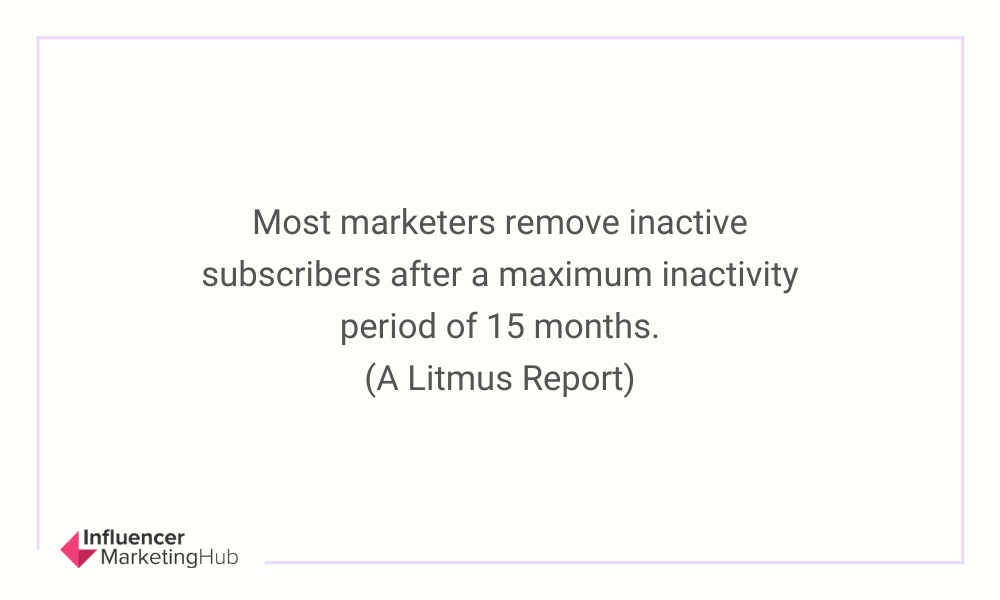
We are going to assume that you did not purchase your email list (which if you did not know is a big no-no). As these recipients never opted to receive your emails in the first place, your emails will simply be flagged as spam.
With that out of the way, what you should do is update your email subscriber list from time to time (about every six months). This entails removing inactive recipients from your list (in other words, those who have not opened your emails for a while). This way, you decrease the chances that your emails will be marked as spam.
14. Conduct A/B testing
An experienced email marketer makes this seemingly optional step a best practice. By taking the time to test elements like different subject lines, images, color schemes, length of the message, etc., you can start to understand your target audience better. Armed with this new insight, you know how to create a better user experience which in turn will boost the effectiveness of your email campaign.
15. Embrace email automation
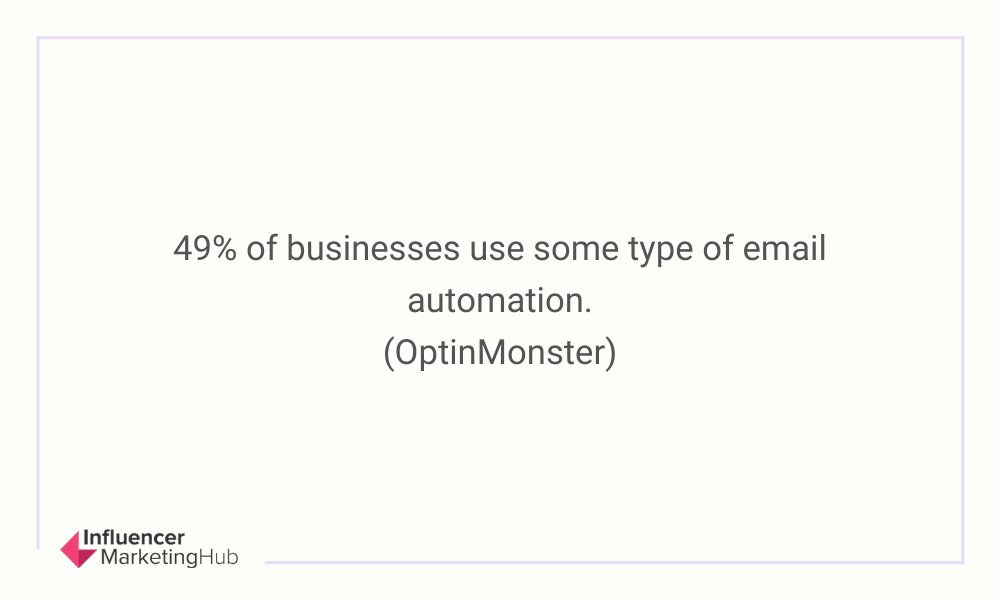
There are several great email automation tools that will help you to get your timing and segmentation just right. From sending your first email address confirmation to following up on cart abandonment, there are various email automation campaigns that you can use.
Another time-saving best practice is to use templates. Creating each new email from scratch is a waste of your time and skill. Most of these email automation tools have free templates that you can refine according to your brand identity.
16. Analyze and adjust
Email best practices are more about than just how to write and send emails. It also involves “behind-the-scenes” work like regularly tracking your results. To know if your email marketing campaigns are indeed effective, you need to analyze rates and results. Once again, third-party email marketing tools, like HubSpot, can help you with the task of tracking the performance of your campaigns.
Frequently Asked Questions
Is email marketing still relevant in 2022?
Yes, email marketing remains extremely important. Email marketing can get you a ROI of as much as $44 for every dollar that you spend on it. Marketers cannot afford to ignore email marketing as it is simply just too big of a platform. It is expected that by 2023 there will be 4.3 billion email users.
What is the optimal time to send promotional emails?
All things considered, the best days to send an email are Tuesdays or Thursdays. In general, people read their emails more during the week than on a Saturday or Sunday. With regards to time, the best time to send promotional emails are at 8 a.m., 1 p.m. and 4 p.m.
Should you remove inactive subscribers from your email list?
Yes! Updating your email subscriber list about every six months is one of the best email practices. This entails removing inactive recipients from your list (in other words, those who have not opened your emails for a while). Most marketers remove inactive subscribers after a period of 15 months of inactivity. This way, you decrease the chances that your emails will be marked as spam.
Should my business use a no-reply email account?
No. Sending emails from a no-reply address will not only hurt your open rates and email deliverability, but also creates poor engagement. After all, email is there for communication. So, to boost your credibility and encourage engagement, rather send emails from an actual human account.
What is email segmentation?
In short, email segmentation refers to when you divide your email subscriber list into smaller groups by categorizing your subscribers based on criteria like demographics, purchase history and interests. This way, you can send them personalized emails that they will find more relevant.
